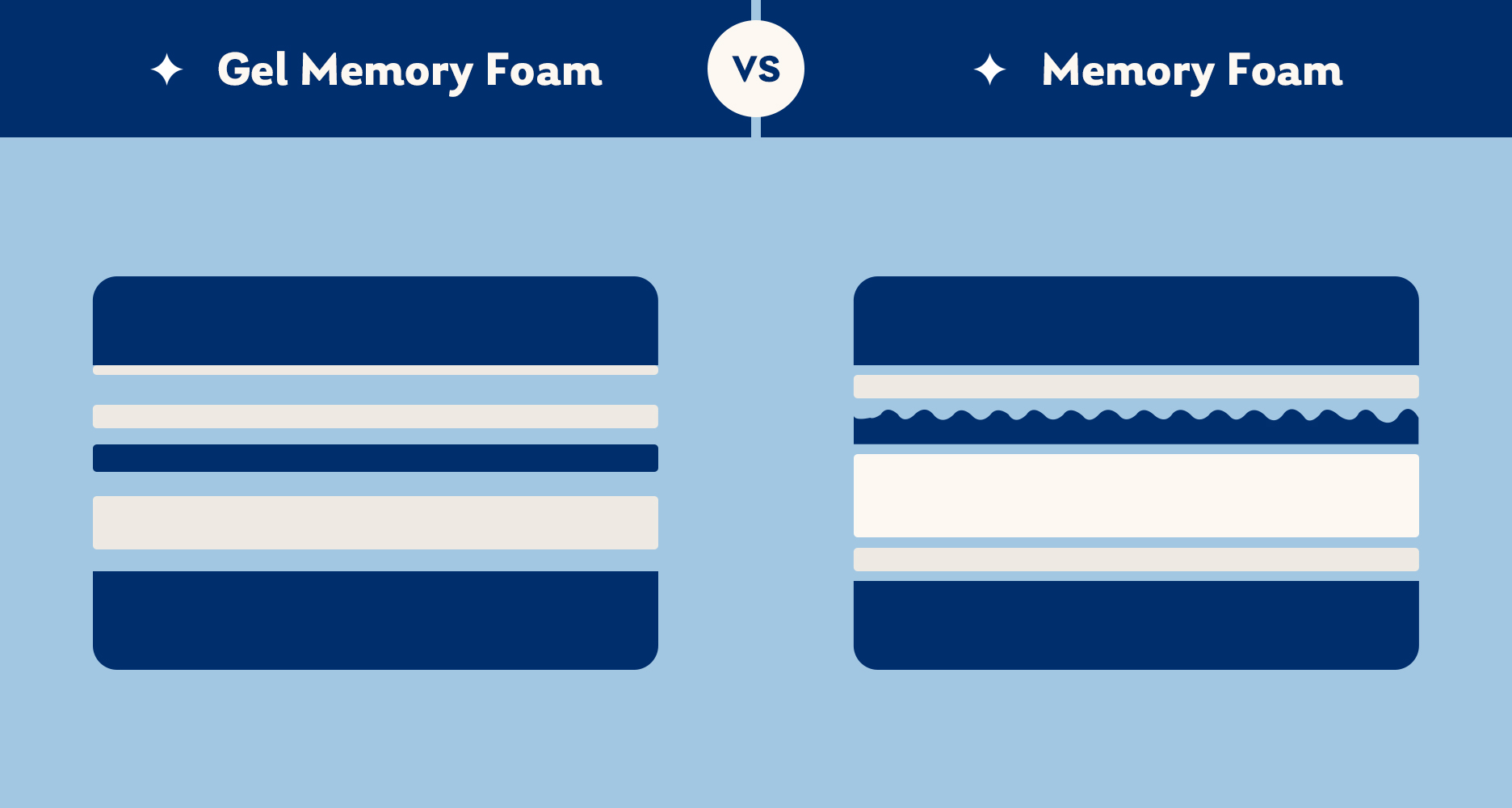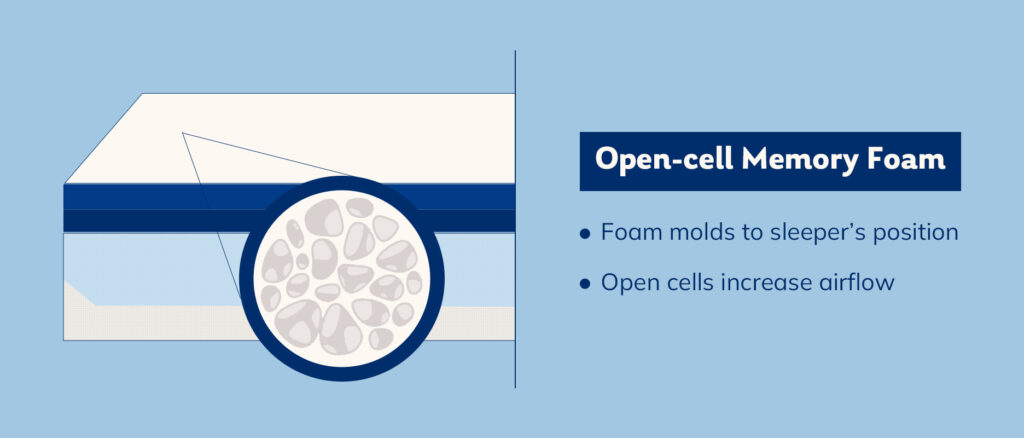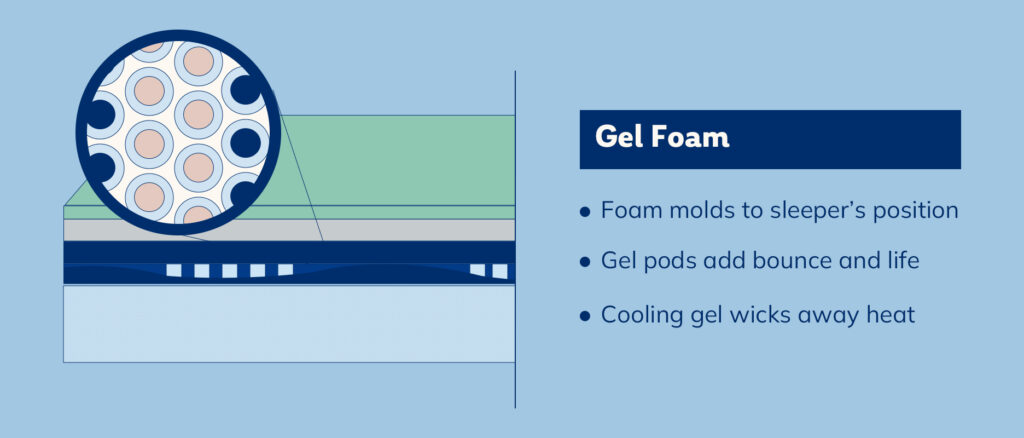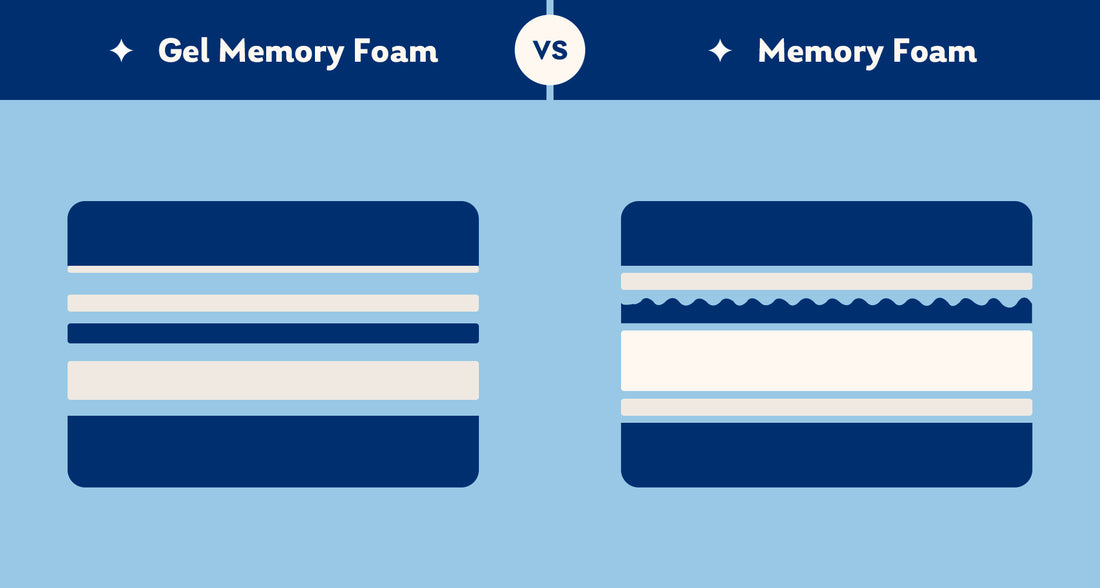
Adding gel to memory foam helps cool down the foam without significantly impacting its feel. That’s why gel memory foam is gaining popularity every day!
Traditional Memory Foam vs Gel Memory Foam
Traditional memory foam retained too much body heat when it first appeared. Manufacturing advancements like open-cell structure help keep the foam cool by circulating air. However, many hot sleepers find airflow alone doesn’t keep them cool enough.
Gel memory foam provides superior cooling capabilities. During production, gel materials are infused directly into the foam. These gel components actively pull body heat away from sleepers through conduction, keeping mattresses cooler all night long.
What’s Traditional Memory Foam?

Traditional memory foam, also known as viscoelastic foam or flexible polyurethane foam, is synthetic – made from processed petroleum products – and has no natural cooling properties.
That’s why, today, traditional memory foam is almost always open-cell. This bubble design promotes maximum airflow, which helps dissipate body heat.
How Traditional Memory Foam Mattresses Are Made
Traditional memory foam is made by whipping liquid polyurethane ingredients into a foam and then vulcanizing the liquid foam inside a mold until it solidifies.
A blowing agent is injected into the liquid foam before it’s allowed to solidify. This blowing agent creates all the bubbles inside the foam that become circulating air pockets once solid.
Traditional Memory Foam Advantages and Drawbacks
Regular memory foam is very durable. You can expect it to last at least a decade and often longer. This type of foam is also one of the most affordable mattress materials on the market. Not to mention it’s also the most adaptable mattress material available.
Traditional memory foam can still regulate its temperature, thanks to air circulation, but gel memory foam is cooler. Traditional memory foam also responds slower to your movements than gel memory foam.
What’s Gel Memory Foam?

While traditional memory foam relies on air circulation, many hot sleepers find its cooling properties insufficient – enter gel memory foam. Gel memory foam doesn’t just circulate cooling air. It also uses thermal conduction to keep you cooler for longer.
Gel memory foam contains ingredients that draw body heat away from you, conducting it further into the mattress. This helps ensure it doesn’t retain heat, remaining cool to the touch for hours at a time.
How Gel Memory Foam Mattresses Are Made
Gel memory foam is manufactured in almost the same way as regular memory foam. However, the gel is added before solidifying when the foam is still in the liquid stage.
This gel may come in the form of beads or liquid swirled into the foam – and some manufacturers even use a thin layer of pure gel on top of their foam comfort layers.
The gel that goes into memory foam is usually either a thermal material that feels cool to the touch and absorbs body heat or what’s known as phase-changing material (PCM). PCM starts out solid at room temperature and then slowly changes to liquid, pulling heat away from you in the process.
Gel Memory Foam Advantages and Drawbacks
Gel memory foam has many advantages. It is much better at keeping you cool than open-cell memory foam and can help even the hottest sleepers regulate their temperatures.
Gel memory foam also retains all the contouring and adaptability of regular memory foam – and it’s more responsive to boot!
However, gel memory foam is often costlier and less durable than traditional memory foam.
How to Know Which Memory Foam Mattress is Right for You
Benefits of Choosing Gel Memory Foam Over Memory Foam
Two types of sleepers do better on gel memory foam: active and hot sleepers. Since gel tends to increase the responsiveness of memory foam, those who like to toss and turn in their sleep may enjoy the increased bounce of gel foam mattresses.
Cooling gel memory foam also offers relief for those who sleep hot. If you wake up with night sweats or feeling overheated, a gel mattress can help regulate your bed’s temperature.
Amazing Gel Memory Foam Mattress Options
MLILY WellFlex 2.0
If you want an ultra-cool and comforting all-foam mattress, check out the WellFlex 2.0. This mattress features our proprietary Gel AeroFusionTM foam that draws body heat away from you and conducts it deep into the mattress.
At the same time, the highly breathable memory foam layer pushes hot air out and breathes cool air in. We’ve also added a transition layer of gel memory foam to help draw heat further away from you for extra cooling power.
These layers of gel foam are wrapped in our highly breathable cooling knit cover to keep air flowing and ensure the sleep surface never heats up.
MLILY ONYX Pro Hybrid Medium
If you’re looking for ultra-cooling hybrid mattress, check out the ONYX Pro Hybrid. Our medium-feel hybrid mattress features a graphene-enhanced cooling knit cover that provides double cooling power – through air circulation and thermal conduction – right off the bat.
Next, we’ve inserted a comfort layer of copper gel AeroFusionTM foam that uses the Thermo conductive power of copper to draw heat away from your body and toward the coil support layer, which helps circulate warm air out of the mattress.
Choosing the Best Mattress Type for Your Specific Needs
There are a few factors to consider when choosing between gel memory foam and traditional memory foam:
Back Pain
Because cooling gel does not alter the contouring ability of memory foam, those with back pain should do well on either gel or traditional foam, as they can expect the same pressure relief and adaptable support from both materials.
Temperature Regulation
Those who get cold at night should avoid gel memory foam, while hot sleepers almost always do better on gel foam over traditional memory foam.
Responsiveness
If you need more responsiveness because you switch positions at night, gel memory foam is likely your best bet because it will bounce back more quickly underneath your body.
Firmness and Support
Both gel and traditional memory foam beds offer a wide range of firmness levels. So, no matter which support level you need, you can find it in both traditional and gel memory foam.
Sleep Temperature
If you need your new mattress to be ultra-cold, then there’s no question that gel memory foam is for you. However, suppose you prefer your mattress to stay closer to room temperature. In that case, you might like traditional memory foam over a cooling mattress because it relies on air circulation to regulate temperature and won’t feel cold to the touch.
Cost
Traditional foam tends to be more affordable than gel memory foam, so a regular memory foam mattress may be more within reach for shoppers on a budget.
Mattress Topper and Hybrid Options
Regular memory foam and gel foam don’t just come in all-foam mattresses. You have other options to consider.
Gel Foam vs Traditional Foam Hybrid Mattresses
Gel foam hybrids offer exceptional cooling and responsiveness. Traditional foam hybrids prioritize durability and affordability.
So, consider a gel foam hybrid if you want an ultra-cool and ultra-bouncy mattress. If you want a hybrid mattress that is a little more durable and budget-friendly, consider a traditional foam one.
Gel Foam vs Traditional Foam Toppers
Memory foam toppers improve the feel of existing mattresses by adding contouring and padding. Add one to your existing mattress for better spinal alignment and pressure relief.
For amplified cooling, gel-infused foam toppers dissipate more heat than your mattress alone, so add a gel foam mattress pad to your mattress if it’s just not cool enough.
Gel Foam vs Traditional Foam: Bottom Line
Memory foam and gel foam differ primarily in their temperature regulation and cost. Thanks to heat-conducting gels, gel foam sleeps cooler but at a higher price point. Traditional memory foam retains more heat yet offers an affordable, durable option.
When you’re out mattress shopping, determine your budget, cooling needs, and longevity preferences. This can help narrow your choice between gel-infused mattresses' advanced temperature control or standard memory foam's resilient affordability. You can decide which technology is the best match by weighing these personal factors.
